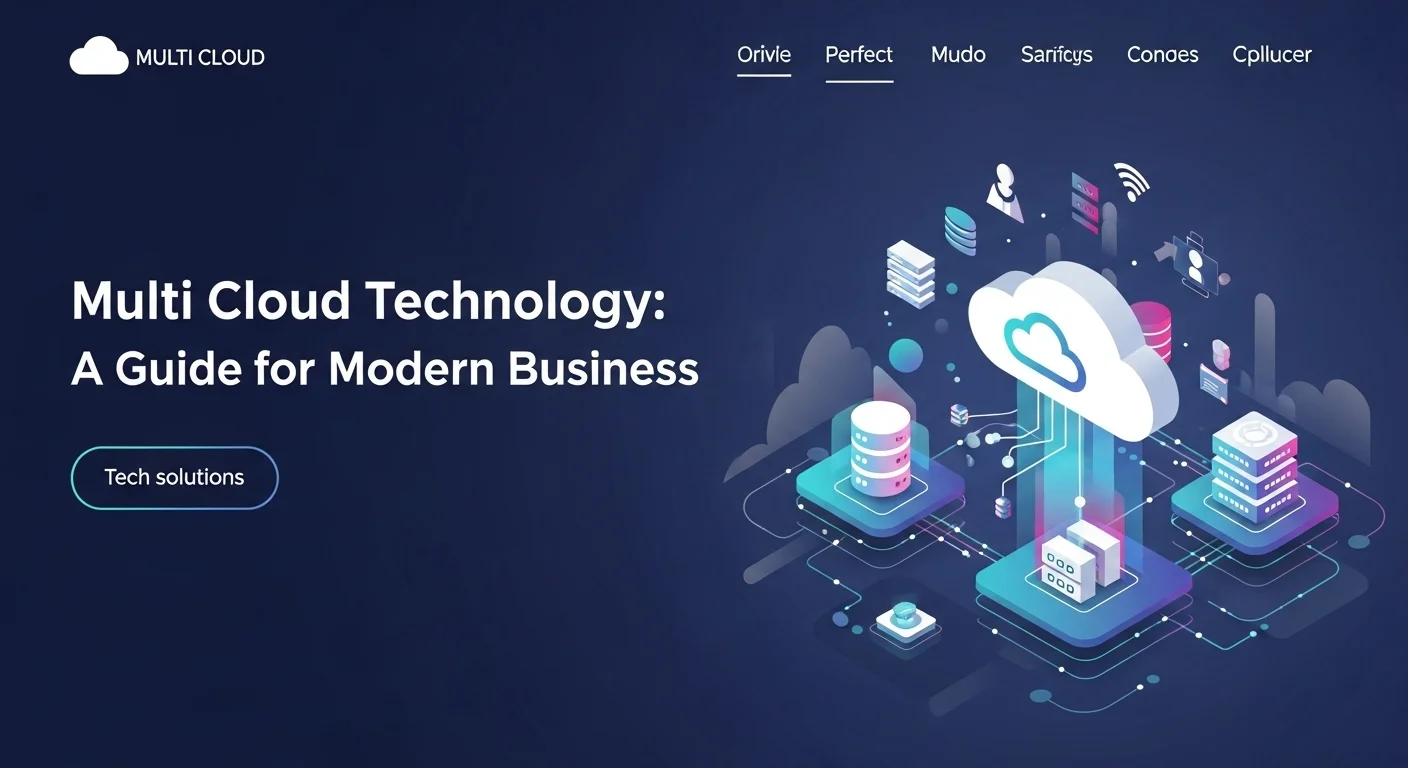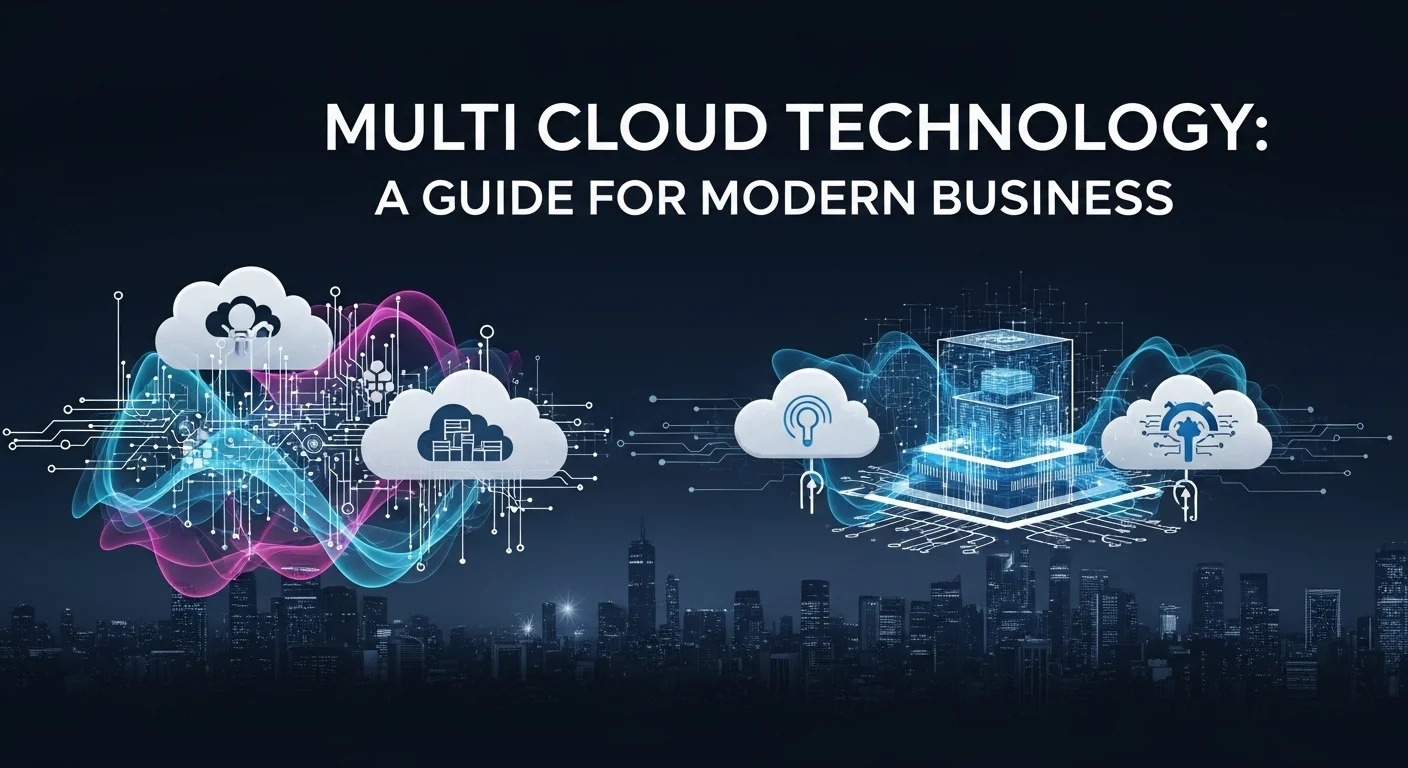Multi Cloud Technology: A Guide for Modern Business

Executive Summary
In the rapidly evolving digital landscape, Multi Cloud technology has emerged as a critical strategy for businesses aiming for resilience, flexibility, and a competitive edge. This article provides a comprehensive exploration of Multi Cloud, a sophisticated approach that involves leveraging cloud services from multiple providers. We delve into what a multi-cloud environment entails, differentiating it from hybrid cloud and highlighting its profound importance in modern technology infrastructure. The discussion covers the core benefits, including cost optimization, avoidance of vendor lock-in, enhanced security, and improved disaster recovery capabilities. Furthermore, we offer a complete guide to business solutions, detailing technical methods, available resources, and strategic comparisons of major cloud platforms. For technology enthusiasts and business leaders alike, this article serves as an essential resource, packed with tips, best practices, and an analysis of the market to help you navigate the complexities and unlock the full potential of a multi-cloud architecture. It's a deep dive into creating a future-proof, agile, and efficient IT environment.
Table of Contents
What is Multi Cloud and why is it important in Technology?
In today's technology-driven world, the term 'cloud' has become ubiquitous. However, the conversation is rapidly shifting from merely adopting the cloud to strategically implementing it. This is where the concept of Multi Cloud enters the picture, representing a significant evolution in how organizations approach their digital infrastructure. At its core, a multi-cloud strategy is the practice of using cloud computing services from two or more cloud providers to power an organization's operations. This is not about putting all your digital eggs in one basket; it's about strategically selecting different baskets for different needs, optimizing for performance, cost, and features. It’s crucial to distinguish multi-cloud from hybrid cloud. A hybrid cloud integrates a private cloud (on-premises infrastructure) with a public cloud. An organization can have a hybrid cloud setup that is also multi-cloud, for instance, by using their private cloud in conjunction with services from both Amazon Web Services (AWS) and Microsoft Azure. However, a multi-cloud environment does not necessarily have to include a private cloud component; it can consist solely of multiple public cloud services.
The importance of this approach in modern technology cannot be overstated. The primary driver is the avoidance of vendor lock-in. Relying on a single cloud provider creates a dependency that can be risky and expensive in the long run. If the provider raises prices, changes its service-level agreements, or experiences a major outage, a dependent business is left vulnerable. A multi-cloud strategy mitigates this risk by distributing services across different vendors, providing businesses with greater negotiating power and flexibility. Another key benefit is the ability to choose 'best-of-breed' services. Different cloud providers excel in different areas. For example, one provider might offer superior machine learning and AI capabilities, while another might have a more robust and cost-effective data warehousing solution. A multi-cloud approach allows a company to pick and choose the best service for each specific workload, leading to a more powerful and efficient overall architecture. This strategic selection process is a cornerstone of modern multi cloud computing, enabling businesses to build highly customized and optimized IT environments.
From a business application perspective, the benefits are tangible and diverse. For e-commerce platforms, a multi-cloud setup can mean hosting their main application on one provider known for its reliability and using another for data analytics to understand customer behavior. For global corporations, it can be a matter of compliance and data sovereignty. Certain countries have strict regulations requiring citizen data to be stored within their borders. By using cloud providers with data centers in those specific regions, companies can ensure they meet these legal requirements. This geographical distribution also enhances performance by reducing latency; serving users from a data center closer to their location results in a faster, more responsive experience. Resilience and disaster recovery are also significantly improved. If one cloud provider suffers a catastrophic failure, an organization can failover its critical applications to another provider, ensuring business continuity with minimal disruption. This level of redundancy is difficult and costly to achieve with a single provider.
To successfully implement such a strategy, businesses need robust multi cloud networking solutions. These solutions are designed to create seamless, secure, and high-performance connectivity between different cloud environments. They address the inherent complexities of managing disparate networks, security policies, and APIs. Advanced networking technologies like Software-Defined Wide Area Networking (SD-WAN) and Secure Access Service Edge (SASE) are becoming integral to managing these complex ecosystems, providing centralized control and visibility over the entire network fabric. The multi cloud hosting landscape has also matured, with providers offering various models to support these strategies. Organizations can manage their multi-cloud environments themselves, or they can opt for managed services where a third-party expert handles the complexity of orchestration, management, and optimization. This allows businesses to focus on their core competencies while benefiting from the power of multi-cloud. The growth in this area is fueling the expansion of the multi cloud networking market, which is seeing a surge in innovation and investment as more companies recognize the strategic imperative of a distributed cloud infrastructure. Finally, the rise of multi cloud SaaS (Software as a Service) applications demonstrates the pervasiveness of this trend. Many modern SaaS products are themselves built across multiple clouds to ensure high availability and performance for their customers, further validating the power and necessity of the multi-cloud model in today's digital economy. The adoption of a multi-cloud strategy is no longer a question of 'if' but 'how,' as it provides the agility, resilience, and strategic freedom necessary to thrive.
The journey into multi-cloud begins with a thorough assessment of an organization's current and future needs. This involves identifying key workloads, data flows, performance requirements, and security policies. It is not a one-size-fits-all solution; the right multi-cloud strategy for a financial services firm will be vastly different from that of a retail company or a healthcare provider. The financial firm might prioritize security and compliance, leveraging clouds that offer specialized certifications and security features. The retail company might focus on scalability and cost-effectiveness to handle seasonal traffic spikes, while the healthcare provider will be concerned with data privacy and HIPAA compliance. This initial planning phase is critical for laying a solid foundation for a successful multi-cloud deployment. It requires collaboration between IT departments, business units, and executive leadership to ensure that the technology strategy aligns with the overall business objectives. The goal is to create a roadmap that outlines which applications and data will reside in which cloud, how they will be interconnected, and how the entire environment will be managed and secured.
Furthermore, the cultural and operational shifts required to manage a multi-cloud environment should not be underestimated. IT teams need to develop new skills and expertise to work with different cloud platforms, each with its own set of tools, APIs, and best practices. This often involves a significant investment in training and development, as well as the adoption of new tools and processes for automation, orchestration, and monitoring. The concept of FinOps, or Cloud Financial Management, becomes particularly important in a multi-cloud context. With resources spread across multiple providers, each with its own pricing model, tracking and optimizing costs can be a significant challenge. FinOps brings together finance, engineering, and business teams to manage cloud costs in a more collaborative and data-driven way. It involves implementing tools and practices for cost visibility, allocation, and optimization, ensuring that the organization is getting the most value out of its cloud investments. Without a strong FinOps practice, the potential cost savings of a multi-cloud strategy can be quickly eroded by inefficiency and waste. Ultimately, a well-executed multi-cloud strategy empowers an organization to innovate faster, operate more efficiently, and adapt more quickly to changing market conditions. It is a powerful enabler of digital transformation, providing the technological foundation for building the next generation of applications and services. As businesses continue to navigate the complexities of the digital age, the strategic adoption of multi cloud computing will be a key determinant of their success.

Complete guide to Multi Cloud in Technology and Business Solutions
Embarking on a multi-cloud journey requires more than just an understanding of its benefits; it demands a detailed and strategic approach to implementation, management, and optimization. This guide provides a deep dive into the technical methods, business techniques, and available resources to help organizations successfully navigate the complexities of a multi-cloud world. The first step is to establish a clear governance framework. This framework should define the policies, procedures, and standards for using and managing cloud services across the organization. It should address key areas such as security, compliance, cost management, and performance monitoring. A strong governance framework ensures consistency and control, preventing the multi-cloud environment from becoming a chaotic and unmanageable 'wild west' of disparate services. A central part of this framework is the creation of a Cloud Center of Excellence (CCoE). A CCoE is a cross-functional team of experts responsible for developing and evangelizing cloud best practices, providing guidance and support to development teams, and driving the organization's overall cloud strategy. This team plays a crucial role in ensuring that the multi-cloud strategy is implemented effectively and that the organization is able to realize its full potential.
From a technical perspective, one of the biggest challenges of multi-cloud is managing the inherent complexity of different platforms. Each cloud provider has its own unique set of APIs, services, and management consoles. To overcome this challenge, many organizations are turning to abstraction layers and infrastructure-as-code (IaC) tools. Tools like Terraform and Ansible allow developers to define and provision infrastructure using a common, declarative language that can be applied across multiple cloud providers. This approach automates the process of setting up and configuring resources, reducing manual effort and ensuring consistency. Kubernetes, the open-source container orchestration platform, has also emerged as a key enabler of multi-cloud strategies. By containerizing applications, organizations can create portable workloads that can be easily moved between different cloud environments without modification. Kubernetes provides a consistent platform for deploying, scaling, and managing these containerized applications, regardless of the underlying cloud infrastructure. This portability is essential for achieving true workload mobility and avoiding vendor lock-in, which are core tenets of multi cloud computing.
Networking is another critical component of a successful multi-cloud strategy. The challenge lies in creating a unified network fabric that securely and efficiently connects resources across different clouds, as well as with on-premises data centers. Traditional networking approaches are often not up to the task, leading to performance bottlenecks and security vulnerabilities. This is where modern multi cloud networking solutions come into play. These solutions leverage technologies like SD-WAN, which uses software to intelligently route traffic over a variety of transport services, and SASE, which converges networking and security functions into a single, cloud-delivered service. These solutions provide centralized visibility and control, automated policy enforcement, and enhanced security for the entire multi-cloud environment. The multi cloud networking market is rapidly evolving, with a growing number of vendors offering innovative solutions to address these challenges. When evaluating these solutions, organizations should look for features such as automated provisioning, end-to-end encryption, and integration with existing security tools.
When it comes to multi cloud hosting, organizations have several options. They can choose to manage their own infrastructure on each cloud provider, giving them maximum control but also requiring significant expertise and resources. Alternatively, they can partner with a managed service provider (MSP) that specializes in multi-cloud. An MSP can handle the day-to-day management of the environment, including monitoring, patching, and security, freeing up the organization's IT team to focus on more strategic initiatives. Another option is to use a multi-cloud management platform (MCMP). These platforms provide a single pane of glass for managing resources across multiple clouds, simplifying tasks such as provisioning, cost management, and security policy enforcement. The choice of hosting model will depend on the organization's specific needs, resources, and risk tolerance. A comparative analysis of the major cloud providers—AWS, Azure, and Google Cloud Platform (GCP)—is also essential. While all three offer a broad range of services, they each have their own strengths and weaknesses. AWS is the market leader with the most extensive portfolio of services and a mature ecosystem. Azure is strong in the enterprise space, with deep integration with Microsoft's other products and a strong hybrid cloud offering. GCP is known for its expertise in data analytics, machine learning, and containerization. A thorough comparison should go beyond just pricing and look at factors such as performance, reliability, security, and the availability of specific services that are critical to the organization's workloads.
The role of multi cloud SaaS is also becoming increasingly significant. Many businesses rely on a multitude of SaaS applications for everything from CRM and ERP to collaboration and productivity. A multi-cloud strategy must account for how these applications will be integrated and how data will be managed across them. This often involves using integration platform as a service (iPaaS) solutions to connect different SaaS applications and automate data flows. It also requires a clear data governance strategy to ensure that data is consistent, accurate, and secure as it moves between different systems. For businesses looking to embark on their multi-cloud journey, a phased approach is often the most effective. Start with a pilot project to gain experience and build confidence. This could involve migrating a single, non-critical application to a multi-cloud environment. The lessons learned from this pilot can then be used to inform the broader rollout. It is also important to establish clear metrics for success. These metrics should go beyond just cost savings and include measures of performance, agility, and resilience. By tracking these metrics over time, organizations can demonstrate the value of their multi-cloud strategy and make data-driven decisions about future investments. In conclusion, a successful multi-cloud strategy requires a holistic approach that encompasses governance, technology, networking, hosting, and a deep understanding of the capabilities of different cloud providers. It is a complex but ultimately rewarding endeavor that can provide a significant competitive advantage in the digital age.
Developing a robust business case is the final, crucial step before full-scale implementation. This involves quantifying the expected benefits and costs of the multi-cloud strategy. Benefits can include reduced IT infrastructure costs, increased developer productivity, faster time-to-market for new products and services, and improved business resilience. Costs will include not only the direct costs of cloud services but also the costs of new tools, training, and personnel. The business case should be presented in a clear and compelling way, demonstrating how the multi-cloud strategy will support the organization's overall business goals. It should also include a risk assessment that identifies potential challenges and outlines mitigation strategies. By taking a comprehensive and strategic approach, organizations can unlock the full power of multi-cloud and position themselves for long-term success in an increasingly competitive and dynamic market. The investment in planning and strategy will pay dividends in the form of a more agile, efficient, and innovative organization, fully prepared for the future of technology.

Tips and strategies for Multi Cloud to improve your Technology experience
Successfully navigating the multi-cloud landscape requires more than just a solid technical foundation; it demands a strategic mindset focused on continuous improvement and optimization. This section offers practical tips and strategies for businesses and technology professionals to enhance their multi-cloud experience, covering best practices in security, cost management, tooling, and future-proofing. The first and most critical area of focus is security. A multi-cloud environment introduces new security challenges, as the attack surface expands and policies must be consistently enforced across disparate platforms. A 'zero-trust' security model should be the guiding principle. This model assumes that no user or device, inside or outside the network, should be trusted by default. Every access request must be authenticated, authorized, and encrypted before being granted. Implementing a zero-trust architecture in a multi-cloud setting involves several key practices. Centralized identity and access management (IAM) is paramount. Using a single identity provider (IdP) like Azure Active Directory or Okta to manage user identities and enforce access policies across all cloud environments simplifies administration and strengthens security. This ensures that users have the appropriate level of access to the resources they need, and no more.
Data protection is another cornerstone of multi-cloud security. A comprehensive data encryption strategy is essential, covering data at rest, in transit, and in use. Organizations should leverage the native encryption capabilities of each cloud provider but also consider using their own encryption keys for an added layer of control. Data loss prevention (DLP) tools can help to identify and protect sensitive data, preventing it from being accidentally or maliciously exfiltrated. Compliance automation is also crucial, especially for organizations in regulated industries. Tools that can continuously monitor cloud configurations against compliance frameworks like GDPR, HIPAA, and PCI DSS can help to identify and remediate violations in real-time, reducing the risk of costly penalties. This proactive approach to security and compliance is fundamental to building trust and confidence in the multi-cloud strategy.
Cost management, or FinOps, is the second pillar of a successful multi-cloud experience. Without disciplined financial governance, the costs of a multi-cloud environment can quickly spiral out of control. The key to effective FinOps is visibility. Organizations need to have a clear and granular understanding of their cloud spending across all providers. This requires implementing cost management tools that can aggregate spending data, allocate costs to specific teams or projects, and identify opportunities for optimization. One of the most effective ways to optimize costs is through rightsizing. This involves analyzing resource utilization and adjusting the size and type of instances to match the actual workload requirements. Automating the process of shutting down unused or underutilized resources, such as development and testing environments, during non-business hours can also lead to significant savings. Leveraging reserved instances and savings plans offered by cloud providers can provide substantial discounts for long-term, predictable workloads. The multi cloud networking market also offers cost-saving opportunities through optimized traffic routing and reduced data egress charges. A mature FinOps practice fosters a culture of cost accountability, where everyone in the organization is encouraged to think about the cost implications of their decisions. This collaborative approach is essential for maximizing the return on investment from multi cloud computing.
The right tooling is essential for managing the complexity of a multi-cloud environment. As mentioned earlier, infrastructure-as-code (IaC) tools like Terraform and container orchestration platforms like Kubernetes are foundational. In addition, organizations should consider a multi-cloud management platform (MCMP) to provide a unified view and control plane. These platforms offer a range of capabilities, including service orchestration, cost management, security policy enforcement, and performance monitoring. They can significantly simplify the operational burden of managing multiple clouds and enable IT teams to be more efficient and proactive. For monitoring and observability, it is important to have a solution that can collect and correlate data from across the entire multi-cloud stack, from the infrastructure layer up to the application layer. This unified view is essential for quickly identifying and resolving performance issues and security threats. The goal is to create an integrated and automated toolchain that supports the entire lifecycle of applications in a multi-cloud world, from development and deployment to operations and optimization. Many modern multi cloud SaaS solutions are built with these principles in mind, offering APIs for easy integration into an organization's existing toolset.
Looking to the future, the multi-cloud landscape will continue to evolve. The rise of edge computing will extend the multi-cloud model to the network edge, creating new opportunities for low-latency applications and services. The increasing adoption of serverless computing will further abstract away the underlying infrastructure, allowing developers to focus solely on writing code. Artificial intelligence and machine learning will play an even greater role in automating and optimizing multi-cloud operations, from security threat detection to cost optimization. To stay ahead of these trends, organizations should foster a culture of continuous learning and experimentation. They should encourage their teams to explore new technologies and approaches and be willing to adapt their multi-cloud strategy as the landscape changes. A great external resource for staying up-to-date on these trends is the Cloud Foundry Foundation, which provides a wealth of information and community resources on cloud-native technologies. By embracing a forward-looking perspective and committing to best practices in security, cost management, and tooling, organizations can not only improve their current technology experience but also build a resilient and adaptable foundation for future innovation. The strategic implementation of multi cloud hosting and robust multi cloud networking solutions will remain critical components of this journey, ensuring that businesses can harness the full spectrum of cloud innovation to achieve their goals.
Finally, cultivating the right talent and organizational structure is a non-negotiable strategy for long-term multi-cloud success. The technology itself is only one part of the equation; the people and processes behind it are what truly drive value. Investing in cross-training programs that enable engineers to become proficient in multiple cloud platforms is essential. This not only increases the team's flexibility but also reduces the risk of being dependent on a few key individuals. Fostering a DevOps culture, where development and operations teams work collaboratively, is also critical. This culture promotes automation, shared responsibility, and a focus on delivering value to the business. The CCoE should act as a facilitator of this culture, providing the tools, training, and support needed for teams to succeed. By building a skilled and empowered workforce, organizations can ensure that their multi-cloud strategy is not just a technical implementation but a true business transformation that drives innovation and competitive advantage for years to come.
Expert Reviews & Testimonials
Sarah Johnson, Business Owner ⭐⭐⭐
The information about Multi Cloud is correct but I think they could add more practical examples for business owners like us.
Mike Chen, IT Consultant ⭐⭐⭐⭐
Useful article about Multi Cloud. It helped me better understand the topic, although some concepts could be explained more simply.
Emma Davis, Tech Expert ⭐⭐⭐⭐⭐
Excellent article! Very comprehensive on Multi Cloud. It helped me a lot for my specialization and I understood everything perfectly.



